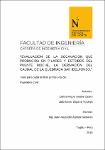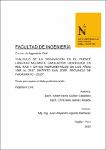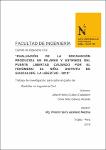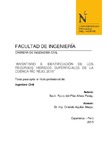| dc.contributor.advisor | Ágreda Barbaran, Juan Alejandro | |
| dc.contributor.author | Avalos Castro, Carlos Miguel | |
| dc.contributor.author | Zegarra Tordoya, Julio Cesar | |
| dc.date.accessioned | 2018-11-19T14:54:18Z | |
| dc.date.available | 2018-11-19T14:54:18Z | |
| dc.date.issued | 2018-10-23 | |
| dc.identifier.citation | Avalos, C. M., & Zegarra, J. C. (2018). Evaluación de la socavación que producirá en pilares y estribos del puente moche, la derivación del caudal de la quebrada San Idelfonso [Tesis de licenciatura, Universidad Privada del Norte]. Repositorio de la Universidad Privada del Norte. Recuperado de https://hdl.handle.net/11537/14115 | es_PE |
| dc.identifier.other | 551.48 AVAL 2018 | es_PE |
| dc.identifier.uri | https://hdl.handle.net/11537/14115 | |
| dc.description.abstract | Tras el desastre que produjo el fenómeno Niño Costero del verano del 2017, el Gobierno Regional y la Autoridad Nacional del Agua (ANA) suscriben un convenio de cooperación institucional para elaborar el proyecto “Desviación de las Aguas de la Quebrada San Idelfonso hacia el Río Moche con fines de Protección contra Inundaciones de la Ciudad de Trujillo y el Distrito de El Porvenir”. En esta coyuntura, los autores, nos abocamos al estudio de las consecuencias que acarrearán la derivación de las aguas de la quebrada San Idelfonso en la cimentación del puente Moche. La presente investigación contiene estudios de antecedentes sobre socavación en puentes en el mundo y en el Perú, así como los fundamentos teóricos en los que se sustentan las diversas fórmulas para el cálculo de socavación. Para el estudio de la cuenca se ha empleado el método de mediciones directas, así como mediciones con herramientas tecnológicas para áreas demasiado extensas. La metodología empleada en el cálculo de socavación general fue por el método de Lischtvan-Levediev, para la socavación en estribos fue por el método de K. F. Artamonov y para la socavación en pilares se utilizó el método de Neill, junto al programa HEC RAS. Para los caudales del río Moche se utilizaron métodos estadísticos con datos proporcionados por las diferentes entidades encargadas de las mediciones meteorológicas e hidráulicas. Los resultados obtenidos del cálculo del caudal de la micro cuenca San Idelfonso y los registros del río Moche nos demuestran que la incidencia de las aguas de la quebrada san Idelfonso representa apenas un 5% del caudal del río, por lo que concluimos que la socavación esperada en los pilares y estribos del puente Moche no representa un peligro para estabilidad del mismo. Consecuentemente, la propuesta de la ANA es técnicamente viable. Sin embargo, pudimos determinarse un error en la apreciación de las autoridades competentes con respecto al caudal que puede generar la micro cuenca San Idelfonso; y es que no se ha considerado que el caudal que se produjo el 19 de marzo del 2017, corresponde a un caudal de rotura de dique, cuyo desborde dejó enormes daños en la ciudad de Trujillo.
Finalmente planteamos unas recomendaciones producto del reconocimiento del terreno hecho tras las dos expediciones realizadas a la cuenca de San Idelfonso, así como de la literatura existente sobre gestión de cuencas. | es_PE |
| dc.description.abstract | After the disaster that produced the phenomenon Coastal Child of the summer of 2017, the Regional Government and the National Water Authority (ANA) signed an agreement of institutional cooperation to develop the project "Deviation of the waters of the Quebrada San Idelfonso to the River Moche for flood protection purposes of the City of Trujillo and the District of El Porvenir.
In this juncture, the authors, we study the consequences that will lead to the diversion of the waters of the San Idelfonso creek in the foundations of the Moche bridge. The present research contains background studies on scour at bridges in the world and in Peru, as well as the theoretical foundations on which the various formulas for the calculation of scouring are based. For the study of the basin the method of direct measurements has been used, as well as measurements with technological tools for areas too extensive. The methodology used in the calculation of general scour was by the method of Lischtvan-Levediev, for the scour in stirrups was by the method of K. F. Artamonov and for the scour in pillars Neill's method was used, together with the HEC RAS program. For the flows of the Moche river, statistical methods were used with data provided by the different entities in charge of meteorological and hydraulic measurements. The results obtained from the calculation of the San Idelfonso micro-watershed and the Moche river records show us that the incidence of the waters of the San Idelfonso stream represents only 5% of the river's flow, which is why we conclude that the expected scour in the pillars and abutments of the Moche bridge it does not represent a danger for its stability. Consequently, the proposal of the ANA is technically viable. However, we were able to determine an error in the assessment of the competent authorities regarding the flow that can be generated by the San Idelfonso micro-watershed; and it is that it has not been considered that the flow that occurred on March 19, 2017, corresponds to a flow of dam breakage, whose overflow left enormous damage in the city of Trujillo.
Finally, we propose some recommendations resulting from the recognition of the land made after the two expeditions to the San Idelfonso basin, as well as the existing literature on watershed management. | es_PE |
| dc.description.uri | Tesis | es_PE |
| dc.format | application/pdf | es_PE |
| dc.format | application/msword | es_PE |
| dc.language.iso | spa | es_PE |
| dc.publisher | Universidad Privada del Norte | es_PE |
| dc.rights | info:eu-repo/semantics/openAccess | es_PE |
| dc.rights | Atribución-NoComercial-CompartirIgual 3.0 Estados Unidos de América | es_PE |
| dc.rights.uri | https://creativecommons.org/licenses/by-nc-sa/3.0/us/ | * |
| dc.source | Universidad Privada del Norte | es_PE |
| dc.source | Repositorio Institucional - UPN | es_PE |
| dc.subject | Puentes | es_PE |
| dc.subject | Hidrología | es_PE |
| dc.subject | DIseño estructural | es_PE |
| dc.title | Evaluación de la socavación que producirá en pilares y estribos del puente moche, la derivación del caudal de la quebrada San Idelfonso | es_PE |
| dc.type | info:eu-repo/semantics/bachelorThesis | es_PE |
| thesis.degree.grantor | Universidad Privada del Norte. Facultad de Ingeniería | es_PE |
| thesis.degree.level | Título Profesional | es_PE |
| thesis.degree.discipline | Ingeniería Civil | es_PE |
| thesis.degree.name | Ingeniero Civil | es_PE |
| dc.publisher.country | PE | es_PE |
| dc.subject.ocde | https://purl.org/pe-repo/ocde/ford#2.01.01 | es_PE |
| thesis.degree.program | Pregrado | es_PE |
| dc.description.sede | Trujillo San Isidro | es_PE |
| renati.advisor.dni | 18108039 | |
| renati.advisor.orcid | https:/orcid.org/0000-0001-5541-2107 | es_PE |
| renati.author.dni | 06569633 | |
| renati.author.dni | 40083265 | |
| renati.discipline | 732016 | es_PE |
| renati.juror | Cabanillas Quiroz, Guillermo | |
| renati.juror | Valeriano Murga, Julio | |
| renati.juror | Valderrama Fernández, Eleodoro | |
| renati.level | https://purl.org/pe-repo/renati/level#tituloProfesional | es_PE |
| renati.type | http://purl.org/pe-repo/renati/type#tesis | es_PE |









